Neotech Amazon Series cables
| Seeking Recognition |
|
|
|
December 2010 |
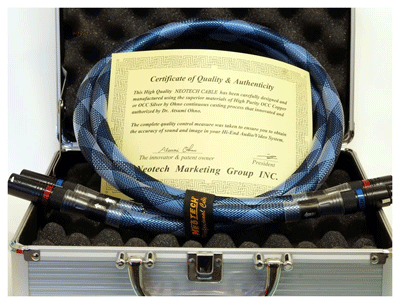
When an high-end audio device garners superlatives like “outstanding soundstage…remarkable clarity…resolution and three-dimensionality that spreads wider and deeper than one expects,” from everyone who hears it, you know it’s probably an excellent product. With a price to match. In the case of the Neotech Amazon series you’d be right on both counts.
Prior Neotech cable designs from Taiwan have acquired a growing interest and glowing reviews here in the States for high-value and low cost. However, the Amazon series is new and it is their most auspicious and expensive product to date. The Amazon speaker cable is a specimen that would make folks, who value weight and substance, proud. And its $8,000 asking price, though attention grabbing, is not excessive when you compare it in terms of build quality with some cables I’ve around that are double and triple that price.
Amazon speaker cables use 7N UP-OCC wire: 99.99999 percent pure silver, Ohno Continuous Casting, rectangular-shaped. 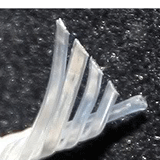 The wire is cryogenically treated and individually insulated with Teflon (polytetrafluoroethylene). Ohno wire was first made known to me by Robert Lee with his series of Acoustic Zen products. Most Ohno-developed wire I’ve encountered since then has had a similar house sound: smooth beyond comparison, with remarkable transparency. But I always felt they did not fare well against the competition when it came to dynamic contrasts and three-dimensional sound-staging.
The wire is cryogenically treated and individually insulated with Teflon (polytetrafluoroethylene). Ohno wire was first made known to me by Robert Lee with his series of Acoustic Zen products. Most Ohno-developed wire I’ve encountered since then has had a similar house sound: smooth beyond comparison, with remarkable transparency. But I always felt they did not fare well against the competition when it came to dynamic contrasts and three-dimensional sound-staging.
Acoustic Revive cables have, however, managed to achieve wonderful sound using Ohno wire, as documented by our own Mike Silverton. Their cables are more than capable of disappearing and allowing the music to flow with no dynamic compression or loss of timbral-rightness and sound-stage. Obviously the shortcomings I heard in past years have been addressed. As a matter of fact, it was the performance of the Acoustic Revive cables that got me interested in taking on the Neotech Amazon when representatives of that company mentioned they had a new reference-level product.
I’ve heard cryogenically treated gear before — the newest Bybee Super Effect Speaker Bullets (review forthcoming) are so treated — and the results are immediately obvious. This intensive deep-freeze procedure has a tremendous upside, although I’m told it is quite costly. In light of all the research and development that went into the Amazon design, I felt honored to have been given the chance to hear and review their sonic character. I was also sent a pair of Amazon interconnects that came in handy when I switched my reference Behold Gentile from DAC-amp mode into DAC-preamp mode and drove a pair of Red Dragon mono blocks. (I’ve been having a very good time of late with the Red Dragons!) And also when I hooked up a new pair of loudspeakers (see below).
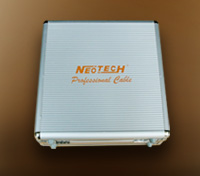 The Neotech Amazon cables arrived in their own separate and aluminum attaché case. Nice. Physically, they’re neither overly heavy or stiff, so no need in worrying about your components (if you’ve got your amps elevated in a rack space as I do). The Neotech Amazons are also rather attractive in terms of its Blue/Grey mesh cover. That said, I would have easily preferred an unassuming matte-black finish as well. After hooking them up and allowing more than 100 hours of play before getting down to anything that would be considered serious, I quietly admired their natural ease and tonality long before the 100 hour mark.
The Neotech Amazon cables arrived in their own separate and aluminum attaché case. Nice. Physically, they’re neither overly heavy or stiff, so no need in worrying about your components (if you’ve got your amps elevated in a rack space as I do). The Neotech Amazons are also rather attractive in terms of its Blue/Grey mesh cover. That said, I would have easily preferred an unassuming matte-black finish as well. After hooking them up and allowing more than 100 hours of play before getting down to anything that would be considered serious, I quietly admired their natural ease and tonality long before the 100 hour mark.
Listening One obvious strength of the Neotech Amazon cables compared with the very natural-sounding Entreq Konstantin cables is the greater dynamic reach it conveyed on the song But Beautiful from Gregory Porter’s new and exciting CD, Water. This beautiful voice and piano recording conveyed the very raw and rare abilities of Porter’s vocal style. The Amazon cables were clearly less dynamically constrained than the far less expensive Entreq wire, and they infused this wonderfully sung ballad with a more convincing sense of the piano’s ebb and flow.
One obvious strength of the Neotech Amazon cables compared with the very natural-sounding Entreq Konstantin cables is the greater dynamic reach it conveyed on the song But Beautiful from Gregory Porter’s new and exciting CD, Water. This beautiful voice and piano recording conveyed the very raw and rare abilities of Porter’s vocal style. The Amazon cables were clearly less dynamically constrained than the far less expensive Entreq wire, and they infused this wonderfully sung ballad with a more convincing sense of the piano’s ebb and flow.
Now, manufacturers may make claims of sonic superiority based on scientific study and analysis of materials, yet the more I listened to the Neotech Amazon wires, the more I got the impression that, yes indeed, this cable is doing something special — regardless of the technical hyperbole. Gregory Porter’s political passions scream out on the hard and gritty 1960 What? from the same CD. This long – over 12-minutes – and funky jazz number features drums blazing, trumpets spitting and trombones blowing hot and heavy in this insightful lyrical retrospective of the tumultuous and tragic 1960s. I find it intoxicatingly new, and very well done, both in terms of musicianship and recording-quality.
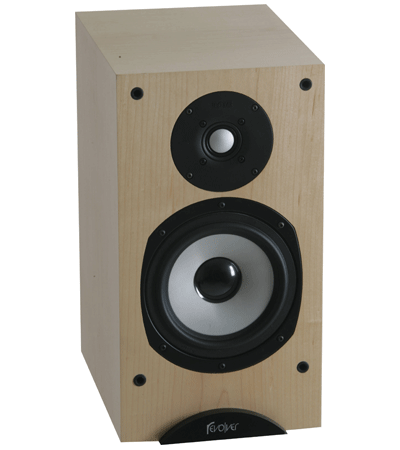 It is also a torture test for any system, so I was doubly impressed at how easily my little Revolver Music 3s, which roll off at 50Hz, handled this track. I got the distinct impression that my system was giving out a much more articulate low end with the Amazon cables. There’s a quality to the bass that is not gaudy, heavy-handed nor pushy. It’s sweet, sure-footed, effortless and natural sounding with great delicacy and nimbleness. The Amazon has a tonal palette that renders the music very even-handedly. Treble energy is neither forward nor faint, hot nor bright; it borders right on the edge between natural and well-lit, but with air and decay that made me smile. I decided to try the Amazons upstairs in the big rig where they’d be up against cables costing more than twice their price.
It is also a torture test for any system, so I was doubly impressed at how easily my little Revolver Music 3s, which roll off at 50Hz, handled this track. I got the distinct impression that my system was giving out a much more articulate low end with the Amazon cables. There’s a quality to the bass that is not gaudy, heavy-handed nor pushy. It’s sweet, sure-footed, effortless and natural sounding with great delicacy and nimbleness. The Amazon has a tonal palette that renders the music very even-handedly. Treble energy is neither forward nor faint, hot nor bright; it borders right on the edge between natural and well-lit, but with air and decay that made me smile. I decided to try the Amazons upstairs in the big rig where they’d be up against cables costing more than twice their price.
My upstairs setup includes Orinda Acoustics Majestic loudspeakers (formally named Sunny Cable Technology) and Bybee Golden Goddess Super Effect Speaker cables (which retail for $18,000 a pair — and I am bi-amping, so double that). I had been using $30,000 per pair Sunny Supreme cables but to my ears they simply were not as good as the Bybees which are simply the best cables I’ve heard. (So much so that I have their digital cable, power conditioner and Speaker Bullets throughout my system, and have been using them as a reference for more than three years now.)
However, installing the Neotech Amazon speaker cables into this system proved an awakening for a couple of reasons. One, it allowed me the privilege to see how my beloved Bybee wire would stand up against some serious competition at half its asking price. Two, it’s been such a long time since I’ve listened to or compared another pricey cable against the Bybees, it would be interesting to see whether I would still like the Bybees as much as I had initially.
The results: Yes, the Bybee wire provides a quicker, punchier and a more resolute bass than the Neotech Amazon cables. But the Amazons are no slouch, even in comparison. It wasn’t one of those “My system fell apart and I rushed to get my original cables back in” sort of scenarios. I was, on the contrary, rather enjoying the differences and similarities between the two cables. As quick and dynamic as the Amazons were in the bass they didn’t offer quite the same level of dynamics, tonal pitch and bass control as I get from the Bybees. If you were to ask me the Bybees’ greatest strength, I would point to bass. It’s not perfect. Nothing (so far) is. To my ears the Bybee midrange, however, is near perfect. But the high-frequencies have been a subject of some contention.
For some who have auditioned this system, the highs are too laid back and don’t have enough oomph. I’m not sure what to say in argument. I happen to enjoy the Bybee perspective on high frequencies. The Neotech Amazon wires do behave differently; they provide a tad more air and emphasis in the highs, characteristics which tend to make the music more “alive,” as if, metaphorically, the recording venue were better illuminated. The overall feel of the Amazons is closer to live in respect to image depth and width, the physical dimensions of the instruments. The Neotech Amazon cables are capable of sounding totally unrestricted in reach, yet they never lose control or sound hard and brittle. I do not think they’re as ultimately resolving as the Bybees though they’re remarkably similar in their unrestricted dynamic intensity, ease and grace, no matter the program source or volume level. And do note that I’ve had cables that are more popular and more expensive than the Bybees fall flat in direct comparison. So I am here to state that the Neotechs not only held its own against the more expensive Bybees, but sounded as if they were cut from a similar cloth.
A rare solo encounter with the Neotech Amazon Interconnects
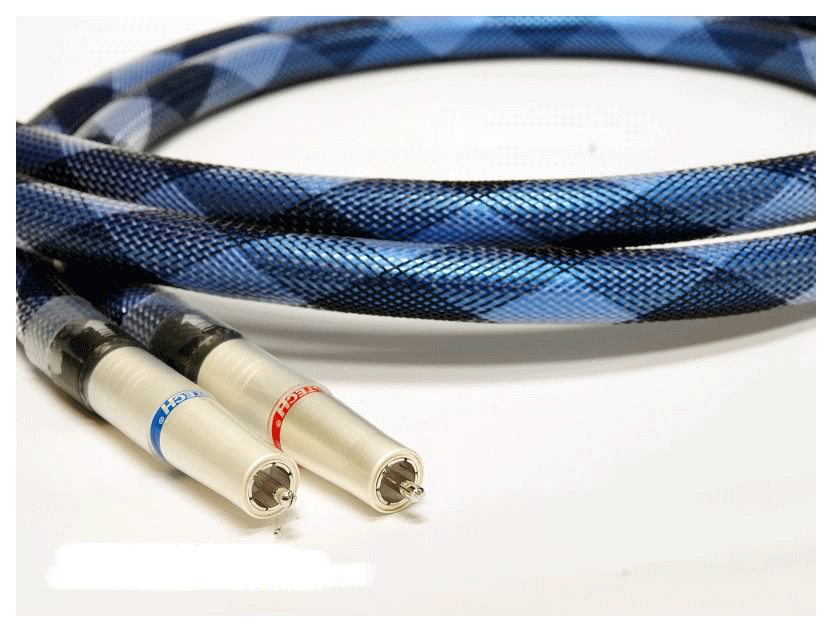
I recently got in a pair of loudspeakers that I think are among the best I’ve heard at their price point. The Precision Transducer Engineering (PTE) Phoenix ($5,500 the pair) are self-powered loudspeakers containing three internal 130-watt class A/B amps, one for each driver, and an electronic crossover. I’ve long heard theories as to why a well-designed self-powered loudspeaker is the way to go. And I have heard crossover-less designs that demonstrate this to a limited degree. However, hearing the big PTE Statement loudspeakers at CES, as well as at the Rocky Mountain Audio Fest, provided clear evidence as to what is possible with an integrated crossover/amplifier/loudspeaker design.
When the Phoenix’s finally arrived for review, they replaced my Revolver Monitor 3s and the differences were quite something! I would not have believed it if I hadn’t heard it with my own ears. Immediacy, dynamics and resolution are the words that came to mind first. Granted, audiophiles will have a certain psychological difficulty having no amplifiers to toy around with and cherish. But if you’re a music lover with a limited budget, and perhaps limited space, and if you care more for music than equipment, then this may be the loudspeaker for you. The only requirement for the Phoenix is a good preamp (or DAC/CD Player with an internal volume control), power cords and a good pair of interconnects. Like the Neotech Amazons. Trust me, there are huge advantages, financial and otherwise, in having no speaker cables at all. Ditto, employing an electronic crossover.
As had the speaker cables, the Neotech interconnects stood out from a crowd of contenders with their immediacy, liquidity and dynamic response. With other cables, some of them very expensive and noteworthy, I just didn’t get the same sense of focus, dynamic contrast and most importantly, enjoyment factor. These strengths of the Amazon interconnects could not have been better illustrated than in this setup.
If you have the financial means to own cables such as the Neotech Amazon series, don’t hesitate placing them on your short list of serious contenders. They are new creations and their only “crime” is limited exposure in the audiophile community. I personally find them to be among the most dynamic and tonally-correct cables I’ve heard. My enthusiastic 2010 Most Wanted Component Publisher’s Choice!

![]()
clement perry
Company Information:
Speaker cable – 2.5M: USD $7800/Pair
Interconnect cable -1.0M: USD $1900/Pair
Interconnect cable with XLR -1.0M: USD $2100/Pair
Website: www.neotechcable.com
Email: info@neotechcable.com
![]()
Don’t forget to bookmark us! (CTRL-SHFT-D)
Stereo Times Masthead
Publisher/Founder
Clement Perry
Editor
Dave Thomas
Senior Editors
Frank Alles, Mike Girardi, Key Kim, Russell Lichter, Terry London, Moreno Mitchell, Paul Szabady, Bill Wells, Mike Wright, Stephen Yan, and Rob Dockery
Current Contributors
David Abramson, Tim Barrall, Dave Allison, Ron Cook, Lewis Dardick, Dan Secula, Don Shaulis, Greg Simmons, Eric Teh, Greg Voth, Richard Willie, Ed Van Winkle, and Rob Dockery
Music Reviewers:
Carlos Sanchez, John Jonczyk, John Sprung and Russell Lichter
Site Management Clement Perry
Ad Designer: Martin Perry





Be the first to comment on: Neotech Amazon Series cables